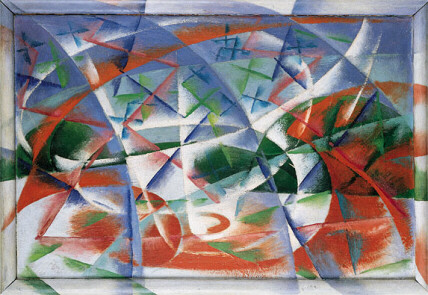| Giacomo Balla | |
|---|---|
 |
|
| Born | July 18, 1871 Turin, Italy |
| Died | March 1, 1958 (at age 86) Rome, Italy |
| Nationality | Italian |
| Movement | Futurism |
| Field | Painting |
| Works | View Complete Works |
Giacomo Balla (1871-1958) was a painter and sculptor from Italy who was best known for his works in the Futurist style. His most productive period was during the late 19th and early 20th centuries, when he was at the forefront of the Futurist movement. His popularity declined with Futurism after World War I but enjoyed a revival shortly before his death.
Personal life
Balla was born in the large city of Turin and had no family background of artistic endeavor. His father worked as an industrial chemist. As a child Balla was more interested in music. However, because the death of his father when Giacomo was nine years old, the boy began to work in a local print shop as an assistant. By the time he had reached young adulthood, he was sufficiently interested in art to want to study it seriously. In 1895, he moved to Rome and married Elisa Marcucci.
Art Style
 Balla’s early paintings were largely in the Pointilist style, although he was also influenced by the ideas of Italian Divisionism. The latter’s Impressionist-like preoccupation with the depiction of light stayed with him throughout his career. However, he became sufficiently impressed with the aims of Futurism to lend his name to the 1910 Futurist Manifesto. After that, the ideas and style of Filippo Tommaso Marinetti grew in significance in Balla’s work, and he added more speed and movement to his paintings.
Balla’s early paintings were largely in the Pointilist style, although he was also influenced by the ideas of Italian Divisionism. The latter’s Impressionist-like preoccupation with the depiction of light stayed with him throughout his career. However, he became sufficiently impressed with the aims of Futurism to lend his name to the 1910 Futurist Manifesto. After that, the ideas and style of Filippo Tommaso Marinetti grew in significance in Balla’s work, and he added more speed and movement to his paintings.
Famous works
Balla’s best-known works come from the period just before World War I. Among his earlier works in the Futurist style is Dynamism of a Dog on a Leash from 1912, an early expression of his skill in capturing dynamism from life. By 1914, his work had become more abstract, with Abstract Speed and Sound being a good example of his evolving style. In the same year, he created his most famous sculpture, Boccioni’s Fist, a striking depiction of spiky, geometrical figures.